Designers and strategists need to keep in mind personas are an essential tool to guide goal/ behavior based UX design process. If two personas are similar in their goals and behaviors, only one is needed. Too many personas would result in potential wasted effort and loss of focus in what really matters.

October 18, 2023
Understanding User Personas in Modern App Development
Written by Mark Coulstring
Overview
-
User personas, integral to modern app development, represent detailed profiles of target users, moving beyond demographics to encapsulate attitudes, motivations, and behaviors. To use them effectively:
-
Understand the User
-
Craft Comprehensive User Personas
-
Drive Informed Design Choices
-
Iterate and Adapt
-
-
In essence, user personas humanize the end user's experience, guiding developers and designers to create apps that resonate with specific individuals rather than generic users.
Time to read: 10 min
Understanding User Personas in Modern App Development
In making phone apps today, user personas are super important. They help make apps that real people like. Let's learn about how they started with Alan Cooper, and how they're used to make apps better. User personas are like profiles that show who might use an app. They help make good choices when making the app, testing it, and fixing things later. Using user personas makes sure apps are all about the people who use them.
Starting User Centric
In today's digital world, a user persona (also referred to as a 'User Archetype') plays a pivotal role in creating user-centric applications that truly enhance people's lives. Gone are the days when they were mere descriptions; they've evolved into powerful tools that guide designers and developers in crafting software tailored to the end user's needs.
When engaging with potential clients, we kickstart our development process by asking two fundamental questions:
- "Who are the target users?"
- "How will they use the product?"
These inquiries form the foundation of a mindset shift from "designing for ourselves" to "serving the end user", setting aside personal biases and egos.
So, how do we transition from self-centered product development to user-centric design? It's a journey that demands time and effort, and we'll break it down for you.
![]()
Who are We? UX/UI Design Experts
- At Seamgen, we conduct robust interviews and information-gathering procedures to ensure complete, comprehensive user persona are created.
- Collaborative teams work quickly to define project scopes with user persona data.
- USA Design Led Development Agency based in San Diego, CA.
- We invite you to contact us for a free consultation!
What are User Persona Profiles?
User persona profiles serve the essential role of delving into the user's psyche, detailing not only how they use a product but also why they're using it and what factors have led them to this point. These profiles consider elements of a user's daily life, influencing design choices and allowing app developers to immerse themselves in the user's perspective.
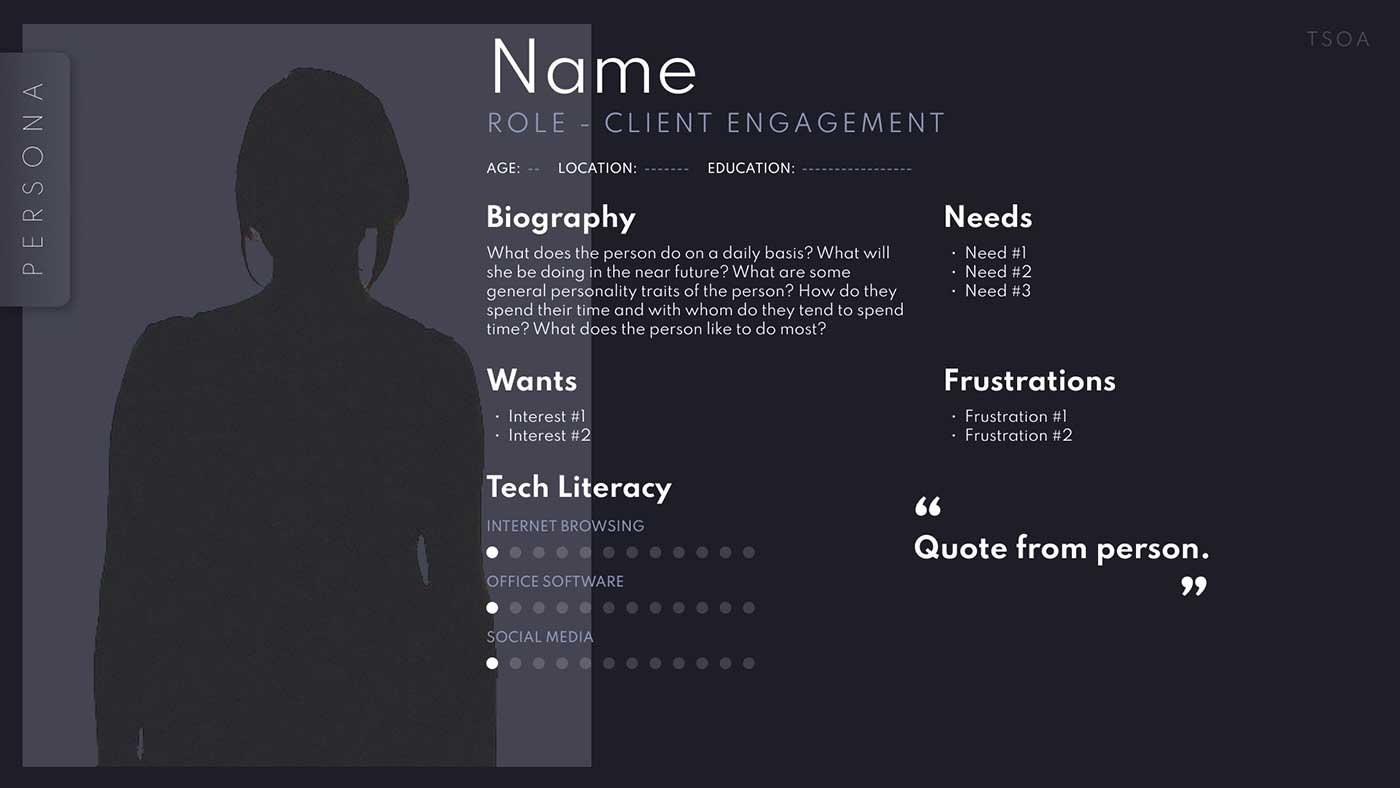
Attitudes, Beliefs, Needs, and Desires
These personas are not mere market segments, real users, or job roles. Instead, they're concise one-page documents outlining the attitudes, beliefs, needs, and desires of a user persona. Multiple personas, each with distinct characteristics and names, guide the design process.
Humanizing the End User
Sholmw Goltz of Smashing Magazine sums it up well: "Each persona…represents a significant portion of people in the real world and enables the designer to focus on a manageable and memorable cast of characters, instead of focusing on thousands of individuals." Personas empower designers to create tailored designs for various user types, designing for a specific individual rather than a generic one.

The ultimate goal is to humanize the end user, encouraging designers to consider all the factors surrounding this personified user's interaction with the app. Factors include age, demographics, income, tech savviness, device preferences, occupation, and leisure activities. We’ll cover additional factors later in the article.
Seamgen Pro Tip: We'll begin your app development journey by asking fundamental questions: "Who are the target users?" and "How will they use the product?" These inquiries lay the foundation for a user-centric approach, ensuring users' needs are prioritized over personal biases.
The History of User Personas
The Father of the User Persona; Alan Cooper
The concept of the user persona owes its origins to Alan Cooper, an American software designer and programmer, who coined the term in the early '80s. Alan Cooper's innovative approach to software design emerged during an unlikely setting - his leisurely walks on the golf course.

As he strolled among the lush greens, he had a habit of mentally envisioning user interactions with the software he was developing. Little did he know that these casual musings would lead to a groundbreaking breakthrough in design clarity.
Shifting Our Understanding
As the '80s progressed, Cooper's user-centric design philosophy gained traction. It wasn't just about developing software; it was about creating software with a deep understanding of the end users and their needs. This shift in mindset laid the foundation for what we now recognize as user personas.
When Alan Cooper transitioned to a consulting role in 1995, his years of experience and insights culminated in a pivotal moment for the world of software design. Thorough user research became the cornerstone of better software design, giving birth to the user persona archetype.
Cooper's consulting work allowed him to refine his ideas further, and he began formalizing the concept of the user persona as a tool for creating user-centered designs.

Mark Coulstring
VP of User Experience, Seamgen
Mark Coulstring, our VP of User Experience at Seamgen, is a seasoned product design and strategy leader with a solid academic foundation from The Art Institute of California-San Diego. With a career that spans roles from Web Designer to Director of User Experience, Mark has showcased his expertise with notable clients such as CVS, Aetna, Oakley, KIA, Intuit, and San Diego Zoo, among others. With over 9 years at Seamgen, Mark has been instrumental in driving user research, strategy, and experience design, solidifying his reputation as a leader in the UX domain.
Goal-Directed Software Methodology
Cooper's ideas continued to evolve and solidify into what we now know as the goal-directed software methodology. This methodology, a subset of user-centered design, combines strategic planning, ethnography, and market research to address business needs, development team capabilities, and most importantly, user goals.

Walk in the User's Shoes
At its core, this approach guides users on a problem-solving journey, empowering them to address their needs through the application. By creating user personas based on in-depth research and real-world insights, developers and designers could now walk in the shoes of their target audience, making informed decisions that truly resonated with users.
Seamgen Pro Tip: Seamgen conducts robust interviews and information-gathering procedures to build complete and comprehensive user persona profiles. This approach involves collaborative teams defining project scopes based on user persona data, ensuring a deep understanding of the end users.
The Role of User Personas in App Development
The role of a user persona in the app development process is paramount, as they serve as the compass that guides every decision, design choice, and testing phase. These personas are not just abstract representations but rather detailed profiles of potential users, derived from extensive research and insights. Let's delve into how user personas inform various aspects of app development.

Informed Decision-Making
Creating a user persona is like putting yourself in the future user's shoes. They bring the end users' voices and perspectives into discussions and decisions. For instance, imagine an app development team is debating whether to include a complex feature that would cater to power users but might overwhelm casual users.
By referring to user personas, which encapsulate the needs and tech-savviness of different user types, the team can make an informed decision that aligns with their primary user group's preferences. This avoids feature bloat and ensures a more user-centric design, with the target user in mind.
Design Choices
A user persona profoundly influences design choices that in turn cater to the diverse needs of the target audience. They help designers understand the specific needs, goals, and pain points of each user group. For example, consider a fitness app designed for both beginners and advanced athletes. One user persona represents a novice seeking guided workouts, while another represents a seasoned athlete tracking performance metrics.
These personas would inform the design team to create a streamlined, intuitive interface for beginners and provide advanced analytics and customization options for experienced users.
"Success can be measured in two ways. The first is that 80-90% of expected users are using it. The second is whether the feature or product itself is meeting the expected goal of the application or feature."
Mark Coulstring
VP of User Experience
Seamgen
Testing and Validation
User personas play a critical role in the testing and validation phases. By using these personas, developers can conduct usability testing with representative users who match the personas' characteristics. This ensures that the app is being evaluated by the actual audience it intends to serve.

An example of this would be if a user persona represents older, less tech-savvy users, usability testing would focus on their ability to navigate the app with ease, and any issues or frustrations they encounter can be addressed before the app's release. This iterative testing process based on user personas ensures a more user-friendly final product.
Iterative Improvement
After the app's launch, user personas continue to inform its evolution. Feedback and usage data can be analyzed in the context of these personas. For instance, if the data shows that a significant portion of users in a particular persona group struggle with a specific feature, it becomes a priority for improvement in future updates. The User persona helps maintain a user-centered approach throughout the app's lifecycle.
Empathizing for Success
User personas are a foundational element in modern app development, influencing decision-making, design choices, and testing procedures. They serve as user advocates, ensuring that the end product resonates with its intended audience.

Building User Personas
Building user personas is a fundamental step in user-centered design and marketing strategies. It involves crafting detailed, semi-fictional representations of your ideal users. By understanding the characteristics, motivations, and pain points of these personas, you can tailor your products, services, and messaging to resonate with your target audience effectively.
By empathizing with users and making informed decisions based on persona insights, developers and designers create apps that not only meet user needs but also lead to higher user satisfaction and success in the competitive digital landscape. Alan Cooper's pioneering work in this field has left a lasting legacy, shaping the way we approach user-centered design in app development today.
Seamgen Pro Tip: User personas are more than just market segments or job roles. They are concise documents outlining the attitudes, beliefs, needs, and desires of a customer base. We use multiple personas, each with distinct characteristics, to empower designers to create tailored designs for various user types and humanize the end user's experience.
Understanding User Personas in Modern App Development
In the realm of modern app development, crafting a compelling user persona profile is akin to developing a captivating character for a story. These profiles serve as the driving force behind user-centered design, enabling developers and designers to create software that resonates with real people. In this article, we will delve into the essential components that constitute a robust user persona profile.
Key Components of a User Persona Profile
The "User Persona" itself is akin to the central character in a compelling story. Beyond mere demographics, it encompasses attitudes, motivations, goals, and pain points. This comprehensive understanding is paramount because it humanizes your audience, transforming them from abstract statistics into relatable individuals. It empowers you to create products and services that resonate on a personal level, ultimately leading to increased user satisfaction and loyalty.
Demographics
Demographics provide essential foundational data for constructing user personas. These tangible details, such as name, age, gender, and location, offer an initial glimpse into your user base. They serve as the starting point, providing context and relatability.
However, to truly understand your users and cater to their diverse needs, it's vital to move beyond the surface-level statistics. This is where psychographics come into play.

Understanding Psychographics
Understanding their educational background, occupation, and family status allows you to appreciate the diverse backgrounds and lifestyles of your users. This awareness is crucial for tailoring your offerings effectively, whether it's designing an intuitive interface for a working parent or crafting engaging content for a retired senior.
"Psychographics" refers to the study and classification of people based on psychological and behavioral characteristics. Unlike demographics, which focus on quantifiable traits like age, gender, and income, psychographics delve into the more nuanced aspects of an individual's personality, values, interests, lifestyle choices, attitudes, motivations, and preferences.
Psychographic information helps marketers and researchers gain a deeper understanding of consumer behavior, enabling them to create more targeted and effective user personas that resonate with specific consumer segments. This information is particularly valuable when trying to connect with an audience on a more emotional and personal level.
By exploring the "Psychographics," you dive deeper into their beliefs, motivations, and aspirations, unlocking the 'why' behind their actions. This insight is invaluable for aligning your product or service with their desires and values, making it a meaningful part of their lives. It's about connecting with your audience on a deeper level, beyond mere functionality.
Behavioral Patterns and Communication Preferences
"Behavioral Patterns" and "Communication Preferences" offer a window into how users interact with technology and information. Understanding their preferred devices, online behavior, and shopping habits helps you optimize the user experience.
For instance, if your user primarily shops on mobile devices, ensuring a mobile-friendly design becomes crucial. Likewise, knowing where and how they prefer to receive information ensures that your messages are seen and well-received.
Giving Users a Voice
The "User Persona Story" brings it all together, weaving a narrative that encapsulates their typical journey. This narrative serves as a guiding light throughout your design and marketing efforts, helping you anticipate their needs and frustrations.

Including a representative quote further personalizes the persona, giving them a voice and reinforcing their attitudes and viewpoints. It's not just data; it's a story that paints a vivid picture of your user, helping your team empathize and align their efforts toward delivering exceptional user experiences.
Informed Design Choices
Lastly, components like "Needs and Expectations," "Challenges and Pain Points," "Buying Power," and "Influences" provide the insights necessary to address user pain points effectively, offer tailored solutions, and influence their decision-making process. These elements transform your user personas from abstract constructs into actionable tools that drive informed design choices and marketing strategies.
In summary, each of these key components plays a pivotal role in creating user personas that are not just user profiles but living, breathing representations of your audience. By understanding these components deeply, you'll be equipped to design and market products and services that resonate with your users on a profound level, fostering loyalty and success in the ever-evolving landscape of user-centered design.
Key Components of a User Persona
The user persona represents the central character who wields the software. It goes beyond demographics to encompass attitudes, motivations, goals, and pain points.

User personas comprise various components that work harmoniously to provide a holistic understanding of your users. These components include demographics, psychographics, behavioral patterns, user environment, tech stack, user persona stories, needs/expectations, challenges/pain points, and buying power.
Each of these elements plays a crucial role in shaping a comprehensive user persona. Let's delve deeper into the significance and intricacies of these components to better grasp their role in creating user personas.
Demographics
Demographics refer to statistical data that describe the characteristics of a population or user group, including factors such as age, gender, income, education, and geographic location. These data help in segmenting and understanding the user base. Here are some examples:
- Name: Give your user persona a relatable name.
- Age: Specify their age range.
- Gender: Identify their gender.
- Location: Mention their geographical location.
- Education: Note their educational background.
- Occupation: Describe their job or profession.
- Family Status: Are the users that you are targeting single, married, or divorced?
Psychographics
Psychographics delve into the psychological and emotional aspects of users, including their values, beliefs, interests, and lifestyle choices. It helps in creating personas that go beyond basic demographics by capturing the user's personality and motivations.
- Attitudes: Understand their beliefs and attitudes towards technology and your app.
- Motivations: Explore what drives them to use your app and their core aspirations.
- Goals and Objectives: Highlight their primary objectives and any challenges they seek to overcome.

Behavioral Patterns
Behavioral patterns involve the study of how users interact with a product or service over time. This includes their actions, preferences, and habits, providing insights into their behaviors and preferences.
- Preferred Devices: Specify the devices they use (e.g., smartphone, desktop).
- Online Behavior: Describe their internet usage habits.
- Shopping Behavior: If relevant, explain their shopping preferences.
Communication Preferences
- Channels: How do they prefer to receive information (email, social media, etc.)?
- Frequency: Note their preferred frequency of communication.
User Environment
User environment refers to the context in which users engage with a product or service, encompassing factors like physical surroundings, online platforms, and social settings. Understanding the user environment is crucial for tailoring user experiences.
- Describe where and when they typically use your app or service.
Tech Stack
A tech stack represents the set of technologies, tools, and software that users employ in their daily activities. Knowing the user's tech stack helps in designing compatible and user-friendly solutions.
- List the software, tools, or apps they commonly use.

User Persona Story
A user persona story is a narrative that portrays a fictional character based on user research, combining demographics, psychographics, and behaviors.
It humanizes the user, making it easier to empathize with their needs and goals. Create a brief narrative that encapsulates their typical journey.
Seamgen Pro Tip: User personas are foundational in modern app development. By empathizing with users and making informed decisions based on persona insights, our developers and designers create apps that not only meet user needs but also lead to higher user satisfaction and success in the competitive digital landscape.
Needs and Expectations
Needs and expectations are the desires and requirements users have when interacting with a product or service. Identifying these helps in designing features and solutions that meet user demands.
- What do they expect from your app or service?
- Identify their specific needs and requirements.
Challenges and Pain Points
Challenges and pain points represent the obstacles, difficulties, or frustrations users encounter while trying to achieve their goals. Addressing these issues is essential for improving the user experience.
- Understand their pain points and frustrations in using similar apps.
Buying Power
Buying power refers to the financial capacity of users to make purchasing decisions. Understanding their buying power helps in pricing strategies and targeting specific customer segments effectively.
Estimate their purchasing power or ability to invest in your product.
- Influences: Identify who or what influences their decision-making process.
- Feedback and Suggestions: Gather any feedback they have about your app or service.
- Scenarios and Use Cases: Describe specific scenarios or situations where they would use your app.
- Tech Preferences: Note their preferences for certain technologies or features.
- Emotional Drivers: Understand the emotions that motivate their actions and decisions.
With a solid grasp of user persona archetypes and their role in software development, it's crucial to integrate them into the design process. Identifying the right personas at the outset can optimize user adoption and enhance your mobile product's problem-solving capabilities. Remember, creating personas is a tool that guides us in crafting products that genuinely benefit users.
Seamgen User Persona Examples
Here are a few examples of User Personas we use here at Seamgen.
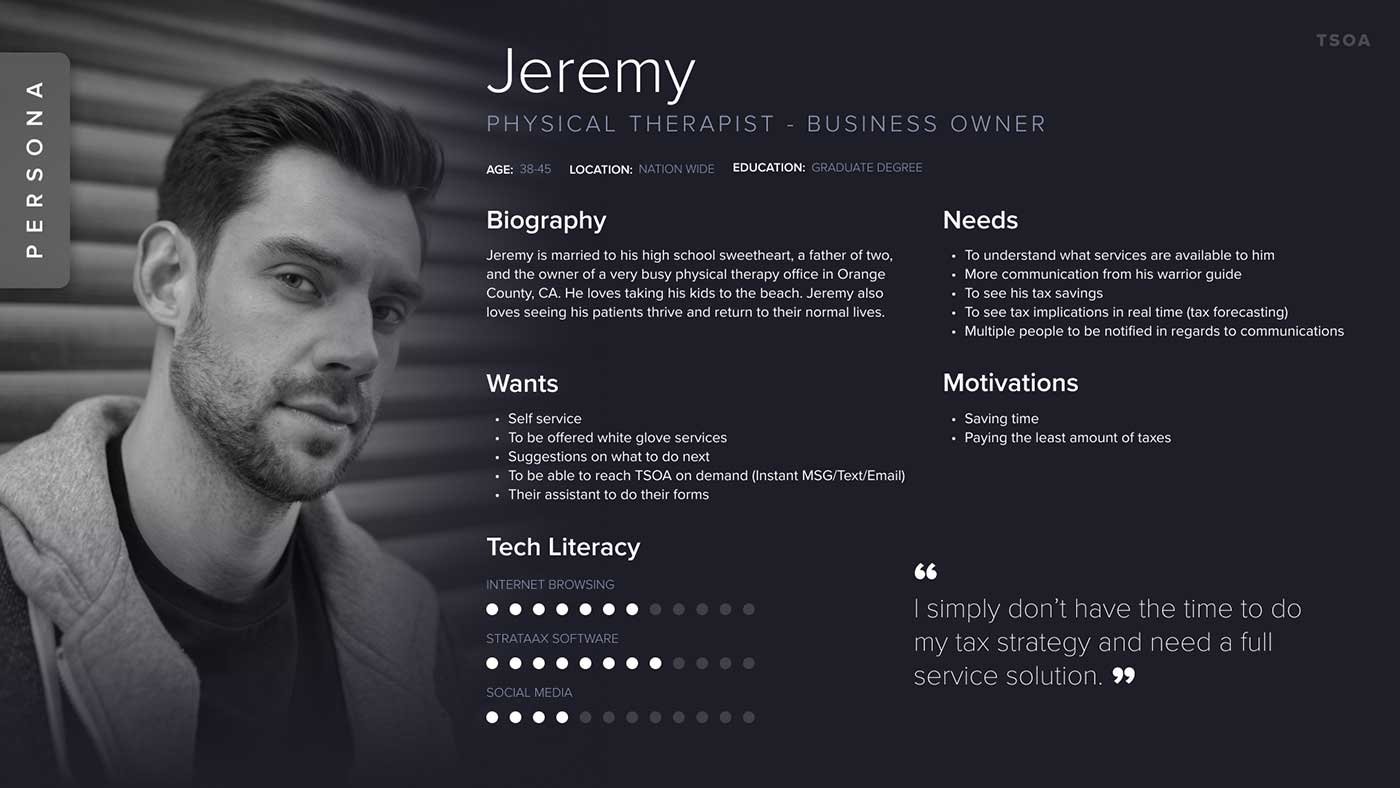
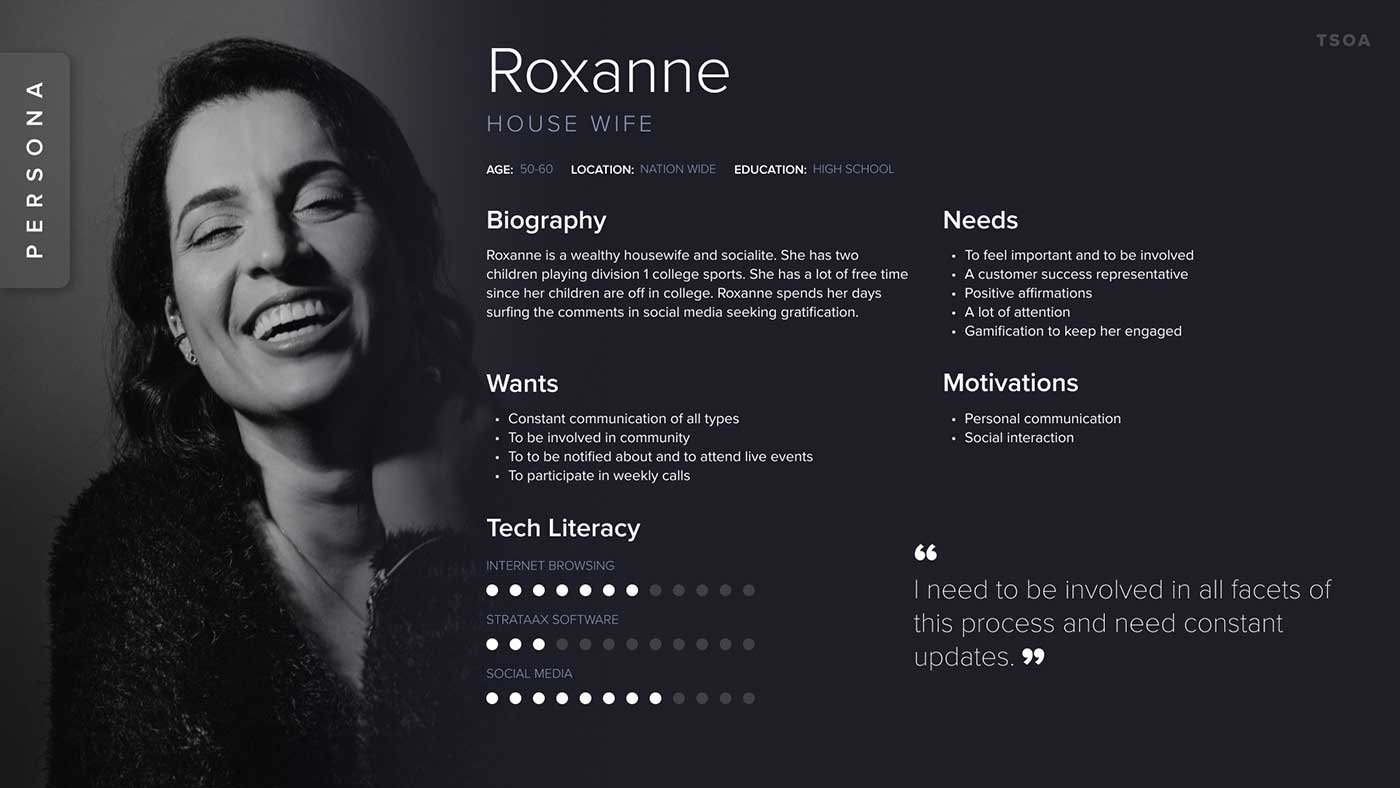
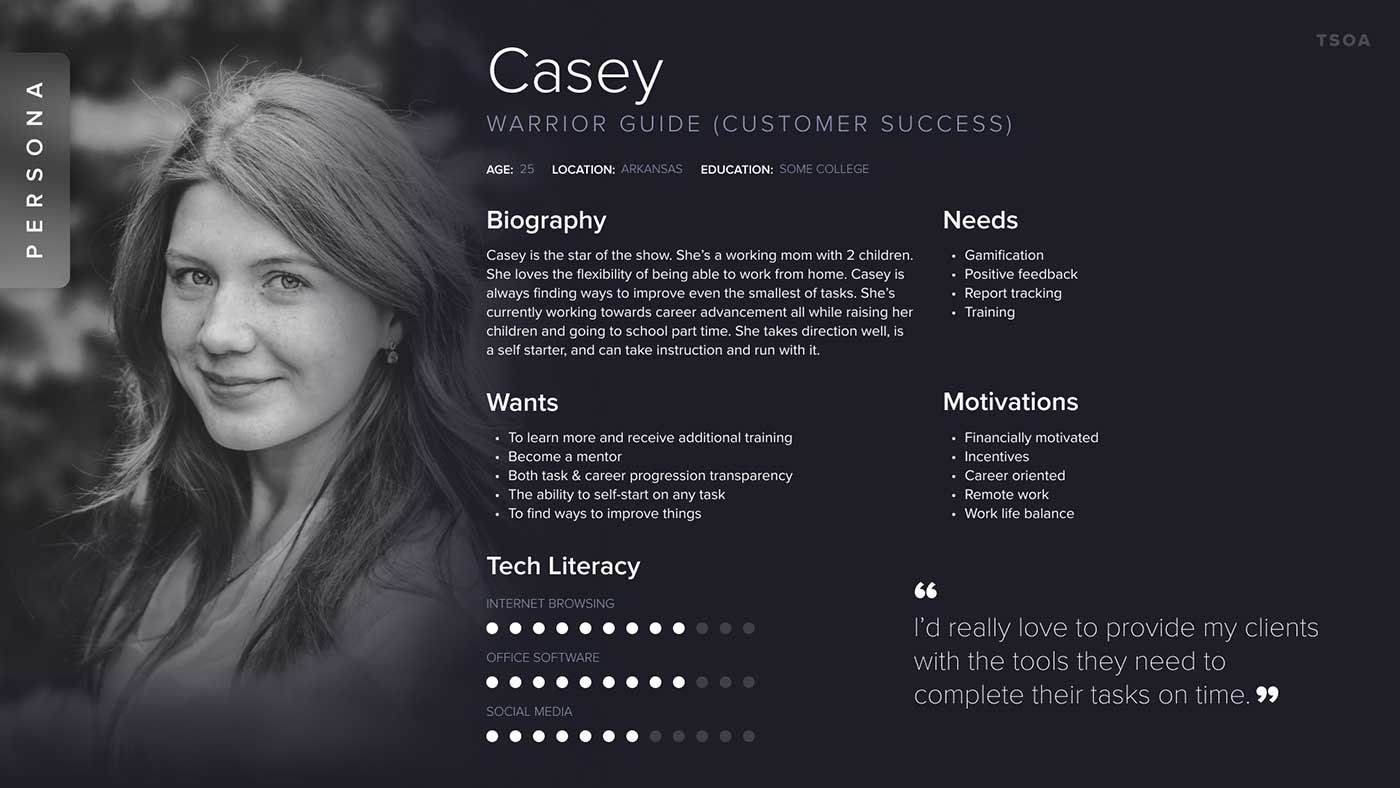
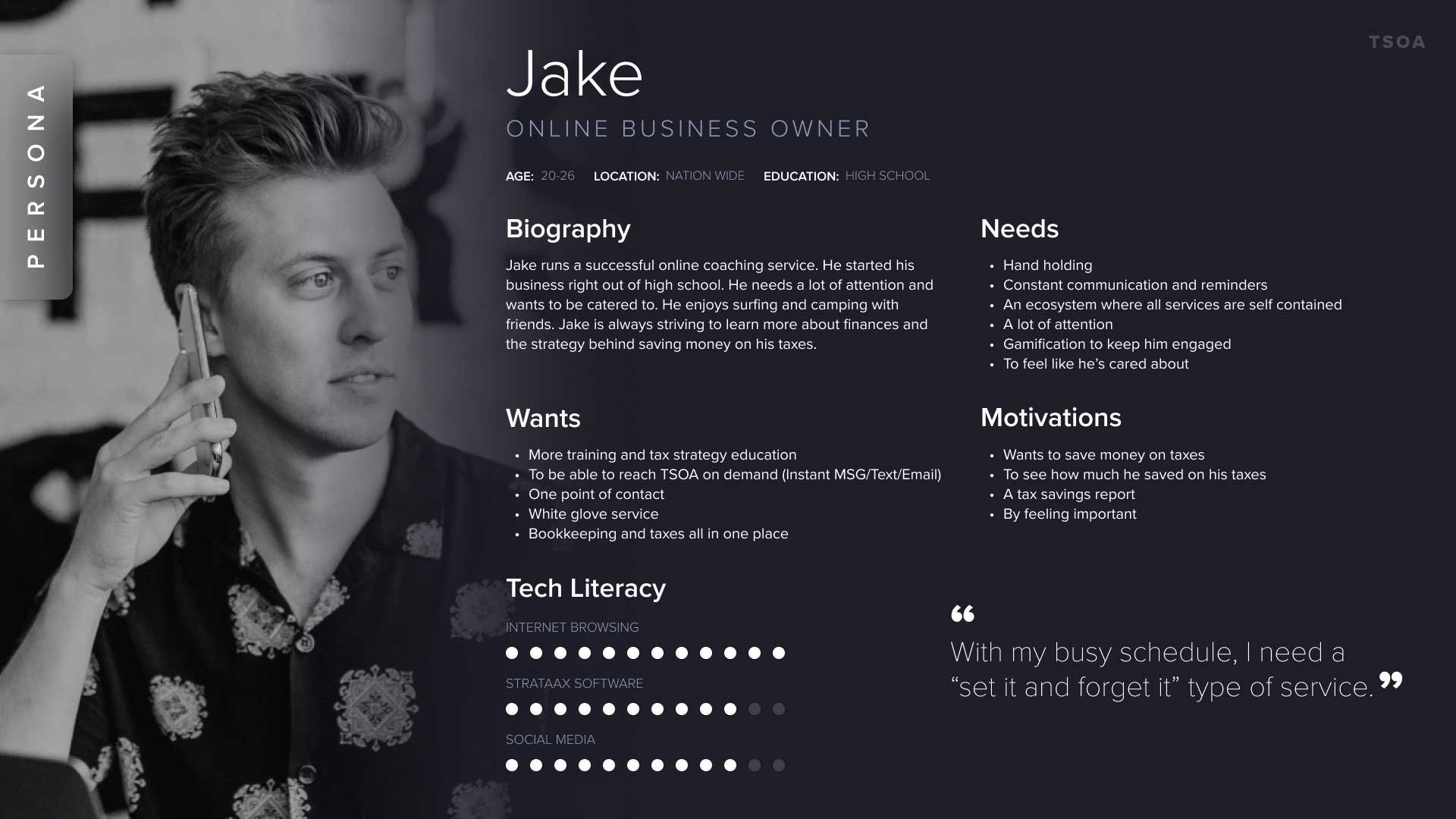
Building User Personas
Building user personas is a fundamental step in user-centered design and marketing strategies. It involves crafting detailed, semi-fictional representations of your ideal users. By understanding the characteristics, motivations, and pain points of these personas, you can tailor your products, services, and messaging to resonate with your target audience effectively.

In this section, we'll walk through the step-by-step process of creating and defining user personas, exploring each component that contributes to their development.
Integrating User Personas into the Project Process
While it’s good to know what goes into creating a user persona in a generic project, it is just as important to know how to apply them in an actual project. Here's a breakdown of how and when user personas should be integrated and updated throughout a project.
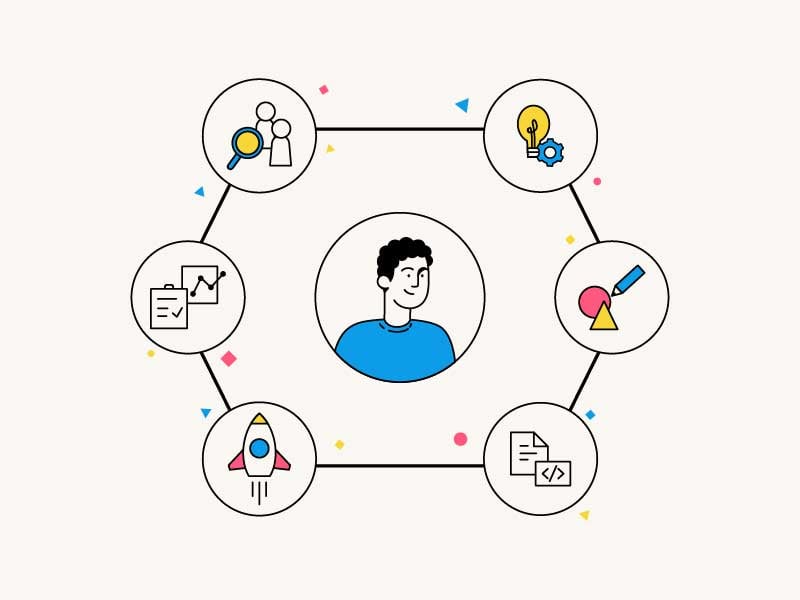
1. Research Phase:
User personas should be the foundation of your design process. At the beginning of a project, conduct user research to gather insights. This could involve user interviews, surveys, and analytics data. From these user research findings, create initial user personas that represent the diverse needs, goals, and behaviors of your target audience.
2. Ideation and Conceptualization:
As you brainstorm and ideate potential solutions and features, refer to your user personas. Ask yourself how each persona would interact with these concepts. This helps in aligning your ideas with user needs and ensures that you're solving real problems.
3. Design and Prototyping:
During the design phase, user personas become instrumental. Create user journey maps and scenarios that walk through how each persona would navigate your product.
This helps in making informed design choices, such as layout, content, and feature prioritization. Continuously validate design decisions against your personas to maintain user-centricity.

4. Usability Testing:
When you've developed prototypes or early versions of your product, conduct usability testing with real users who match your personas. This iterative process allows you to gather feedback and insights, making necessary adjustments to improve the user experience.
5. Ongoing Updates:
User personas should not be static documents. They should evolve as your project progresses and as you gather more data and insights. Regularly update personas based on user feedback, usability testing results, and changes in your target audience's behaviors and preferences.
6. Cross-Functional Collaboration:
Ensure that the entire project team, including developers, designers, and marketers, has access to and understands the user personas. Encourage collaboration and discussions around how each team's work aligns with the personas' needs.
7. Post-Launch Evaluation
Even after the product is launched, user personas remain valuable. Monitor user feedback and analytics data to see if the personas are still representative of your actual users. Update them if you notice significant shifts in user behavior or demographics.
Incorporating user personas into every phase of the design process keeps the end user at the forefront of decision-making and leads to a product that resonates with your target audience. It's essential to view personas as dynamic tools that adapt as your project evolves, ensuring that your product remains relevant and user-friendly.
Seamgen Pro Tip: After the app's launch, we use user personas to guide ongoing improvements. This way, we analyze user feedback and usage data in the context of these personas to prioritize enhancements that resonate with specific user groups, maintaining a user-centered approach.
User Personas FAQ's
2
What are the 3 categories of user personas?
+
Demographics, motivations, and pain points are all data points that a UX designer may collect to create a user persona. User personas are NOT the same as buyer personas. There are THREE different types of user personas: lightweight, qualitative, and statistical.
3
What are five best practices to consider when creating user personas?
+
- Don't confuse demographic and persona...
- Start small, and expand after...
- Don't just 'come up' with personas: base them on real people...
- Talk to your users in person, if you can...
- Keep an open mind...
4
What are the weaknesses of user personas?
+
Those who agree that extensive research is required to create efficient personas also understand how it can be exhausting since the user personas are ever-changing (as user behavior is ever-changing).
Stay User Centric
As designers and software creators, we all bring our unique perspectives, biases, and tastes to the table. Creating user personas helps us make informed decisions, therein allowing us to create products that users love and that enhance their lives. Taking the time to create these personas enables designers and developers to better target users.

In app development, user personas are a cornerstone of the goal-directed software methodology, a subset of user-centered design. This methodology combines strategic planning, ethnography, and market research to address business needs, development team capabilities, and user goals. It guides users on a problem-solving journey, ensuring that app development aligns with user expectations and provides genuine value.
By integrating user personas into the design process, developers become advocates for the user, resulting in products that users love and find valuable.

Written by
Mark Coulstring
VP, User Experience, Seamgen
Product Design & Strategy Leader, Worked with CVS, Aetna, Oakley, KIA, Intuit, ViaSat, AARP, Experian, and many more.

Do you need a premier custom software development partner?
Let’s discuss your modernization strategy and digital application goals.
Let's Connect
Up Next






